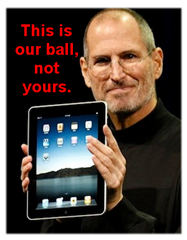The Google Kill Switch
 Google flipped the app kill switch this weekend, removing 58 apps that had been downloaded to over 250,000 phones. This is part of the 21 they removed before. They say now there were 58 applications. So, late Saturday night, Google flipped the switch that is able to remove the apps from the phones they were installed on.
Google flipped the app kill switch this weekend, removing 58 apps that had been downloaded to over 250,000 phones. This is part of the 21 they removed before. They say now there were 58 applications. So, late Saturday night, Google flipped the switch that is able to remove the apps from the phones they were installed on.
The switch is part of the store and can remove apps with no user interaction. According to Google’s mobile blog, four actions where taken:
- They removed the apps from the market, suspended the developer account, and contacted law enforcement
- They’re remotely removing the apps from the affected devices.
- Pushing an security update to the affected devices to prevent further access to the by the developer.
- Updating the market with a number of measures to prevent additional malicious applications.
If you think your device was affected, there is more information available at the Android Market help center.
This ought to be considered a positive development in this interesting story. Amazon should take note,  considering they’re getting ready to start their own android app store.
considering they’re getting ready to start their own android app store.
Google has had the kill switch since 2008 and used it for the first time in 2010.
Always read the user reviews before downloading an app from the Android market. A little common sense goes a long way when installing an application, also. For example, would an application the works as a stop watch really need access to your contacts or the GPS built into your phone? So remember to read the permissions used by the applications before installing.
Top 10 Stories and Succinct Spiels
This week had some pretty interesting developments! From the iPad2, an Android Trojan, and early press blitzes from SXSW. It’s Friday, I’m behind on my projects, and I broke one of my data classes last night. So after a quick firewall fix, I’m heads down.
However, here’s some of the stuff that caught my eye:
#10- SXSW app hope to monetize serendipity
Startup Yobongo is hoping to jump start usage at SXSWQ. Basically, it’s an iPhone app that lets you chat with strangers nearby with similar interests. Supposedly, it’s fun and addictive once you get the hang of it.
#9- Windows for tablets coming in 2012
Windows 8 is coming 2012, and there are reports of a version targeting tablets. Redmond has done this before. Maybe it’ll be improved by the partnership with Nokia?
#8- AT&T goes all Minority Report on you…
On Monday, AT&T rolled out ShopAlerts. I can’t wait to see the first compulsive shopper swerve across three lanes of traffic to get that Juicer at Kmart.
#7- Schmidt says sales of mobile more massive than they thought
You like that word play? Anyway, Dr. Schmidt, during his opening keynote at 2011 IAB, said mobile growing faster than anyone thought.
#6- Rumors that Jonathan Ive might be leaving Apple.
Why should you care? Cause he’s the VP of industrial design. As in, all those cool Apple products are created under his oversight. Rumors are flying..
#5- Reports indicate Android winning the smartphone wars
According to Nielsen, Android is becoming a dominate smartphone OS in the United States. The data is still a little murky, but this is an interesting development.
#4- GMail hiccups under the radar
15,000 accounts. Lost emails. Passwords being force reset. Chaos. Dogs and cats living together.
#3- Sprint event on March 22 announced – same day as Samsung
Will we see a new 9 Galaxy Tab? Will Sprint also unveil an Evo 2? Samsung rumored to be changing Tab pricing, also. 
Oh, the huge manatees!
#2- Trade in numbers indicate massive iPad 2 demand.
Retailers offering trade-ins for technology have seen an explosion of iPad tradins. Gazelle and NextWorth are talking about it. I may not have been impressed, but seems many of you are!
#1- Apple unveils iPad 2
The Apple App store and the Android Malware scare of 2011
Apple can come under a lot of criticism for their seemingly arbitrary practices when it comes to approving an app for the Apple app store. They’ve provided little feedback to developers on occasion, prompting the lonely blog posts and begging for help in forums. However, if you step back and look at it, Apple tends to approve a lot of apps that, frankly, are just plain wacky. Remember the farting app? How about the baby shaking app?
 Obviously, Apple’s approval process is not above bathroom humor. Granted, I’ve not yet published an app in the Apple app store; so everything I see is based on my research and reading.
Obviously, Apple’s approval process is not above bathroom humor. Granted, I’ve not yet published an app in the Apple app store; so everything I see is based on my research and reading.
Some of the criticism could be considered well founded, depending on your perspective. Apple is charging a lot of money for applications / services that let users subscribe to data via the app. In fact, the rates are so high many of the music streaming apps might become unavailable on the Apple products. Apple, in traditional apple fashion, is getting aggressive about monetization. It’s their market, their product, and their technology. Many of the critics of Apple’s subscription tariffs seem to forget this. Apple never said you could play for free.
Apple, however, does some things exceedingly well and the advocates of “openness” should take heed. Take the app store approval process as a microcosm for everything that is right and wrong in this debate. Apple scans the code of submitted apps to make sure they don’t violate the terms of service (TOS). Apple doesn’t allow certain things to happen on their platforms. It’s not perfect, but its better than having zero oversight into the process.
There are some things that will get your app rejected from by Apple. If you notice, most of these accomplish the goals of a) protecting the user and b) protecting the user experience. Some would add c) protect Apple’s revenue stream, but that’s a different debate.
Apple will reject your app if (this is not a definitive list):
You write crappy code.
As in, your app crashes or doesn’t do what it’s supposed to do.

+1 for the User (Stability)
–0 for the developer (meh, your app shouldn’t crash)
Your app overlaps with what Apple is already doing.
As in, the iPhone is a music player; so that’s not an area you can play in.

+0 for the User (The Apple features work well, so we’ll never know)
–1 for the developer (Limits your options a bit)
Your app changes how the phone works.
A great example of this would be syncing iTunes over the network. It doesn’t matter if the user wants it, that is not how Apple wants it.

+1 for the User (Consistency)
–1 for the developer (No opportunity to improve the experience)
Your app runs interpreted code.
Two words, Adobe Flash. Another word, malware.
+1 for the User (Less Security risks, better performance and thus a better experience)
–1 for the Developer (Learn Objective C or use a tool that compiles to native code).
Your app uses too much bandwidth.
Network intensive apps will get rejected. It’s a phone, not a web server!

+1 for the user (Helps prevent the $1000 phone bill!)
–0 for the developer (seriously. it’s still not a web server)
Its things like informing the user that there may be fees if your app is running because it uses data, or letting the user swipe between screens like the native OS that your app should strive for.
Don’t re-invent the UI wheel on the iPhone, because Apple doesn’t want you to, and for good reason. Once the user learns how to interact with their iPhone, all the apps can be interacted with the same way. Thus, the iPhone and iPad have a consistently great user experience.
 So, for all the criticism heaped at Apple for the way they manage the apps on their platform, their actions directly benefit the end user. This ultimately helps Apple’s bottom line. This isn’t bad a bad thing; they created the market so it is theirs to benefit from as they see fit. Their pro-user experience is demonstrably profitable, which raises the bar in the industry. Proponents of open platforms and systems (philosophies without which the Internet would not be what it is today) are usually some of the most vocal. To them I say, Apple never promised a fair playing field. It’s all about the user experience, so either you will compete or you won’t.
So, for all the criticism heaped at Apple for the way they manage the apps on their platform, their actions directly benefit the end user. This ultimately helps Apple’s bottom line. This isn’t bad a bad thing; they created the market so it is theirs to benefit from as they see fit. Their pro-user experience is demonstrably profitable, which raises the bar in the industry. Proponents of open platforms and systems (philosophies without which the Internet would not be what it is today) are usually some of the most vocal. To them I say, Apple never promised a fair playing field. It’s all about the user experience, so either you will compete or you won’t.
In contrast, almost anyone can submit an app to Google’s app store. In the past few weeks, someone download several popular free games and modified them. In the new, modified versions they put code that would to hijack your phone and download more software off the Internet and execute it. Basically, the new versions had a virus in them. They took the new modified versions and uploaded them to the Android market. Over 250,000 people downloaded the Trojan applications before Google pulled them off the market. Interestingly, one of the developers of one of the original apps had been complaining to Google that his software had been pirated for weeks and Google took no action. It seems it wasn’t until their Android operating system’s reputation was threatened that they took action.
250,000 people downloaded the Trojan applications before Google pulled them off the market. Interestingly, one of the developers of one of the original apps had been complaining to Google that his software had been pirated for weeks and Google took no action. It seems it wasn’t until their Android operating system’s reputation was threatened that they took action.
This would not have happened in Apple’s app store. Which is why it is a Google’s Android marketplace is inferior for both the end user and the developer right now.
In the end, Apple never promised you an open rose garden, but they are delivering a consistent and reasonably secure one. Google, on the other hand, is giving you an open bazaar. They aren’t, however, providing security for anyone but themselves, it seems.